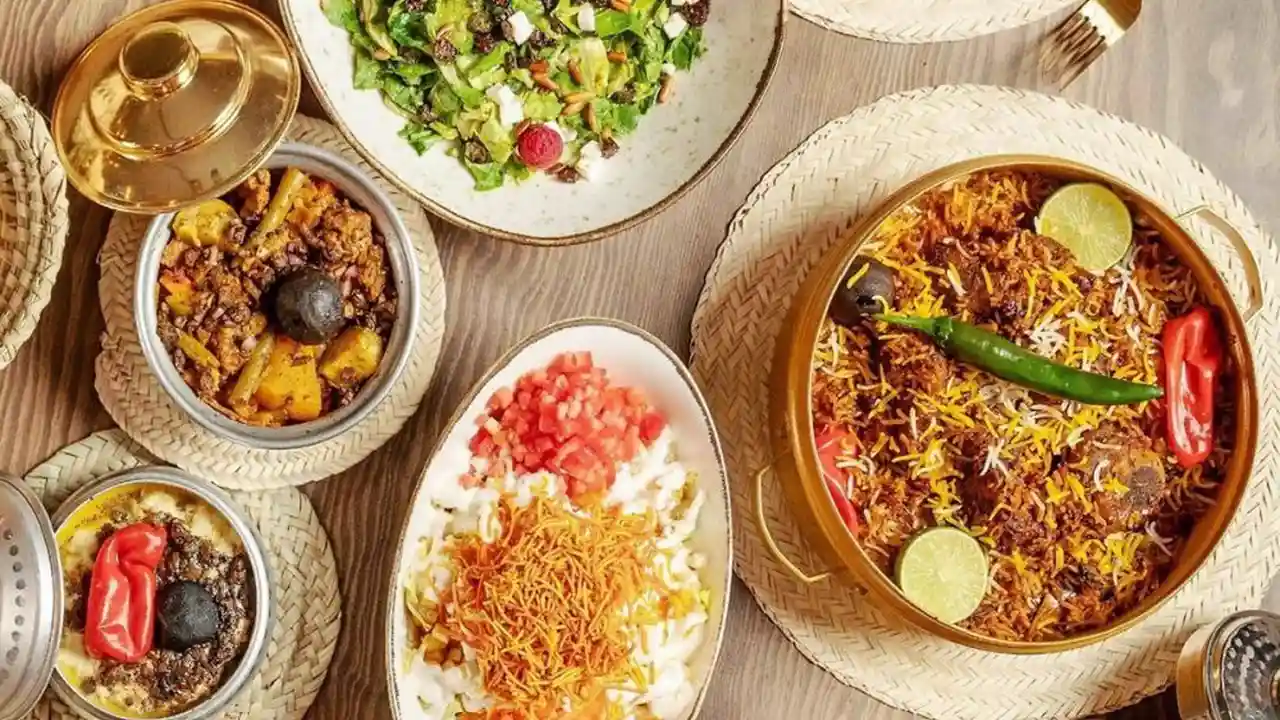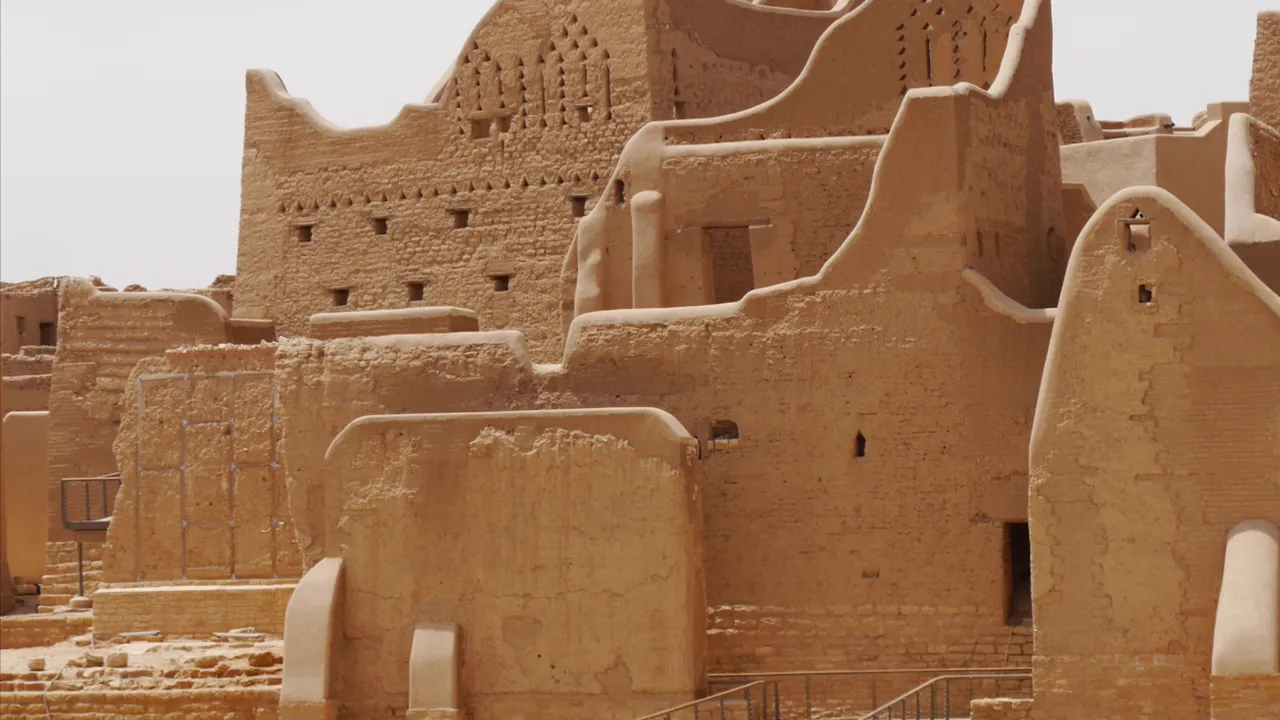
Unveiling Saudi Arabian Cuisine A Journey Through Flavors
Saudi Arabian cuisine is a fascinating blend of Bedouin traditions, regional specialties, and influences from neighboring countries. From the hearty stews of the desert to the fragrant rice dishes of the coast, the food of Saudi Arabia tells a story of history, culture, and hospitality. Let's embark on a culinary journey to discover the diverse and delicious world of Saudi Arabian food and drink.
Kabsa The National Dish of Saudi Arabia Explained
Kabsa, often considered the national dish of Saudi Arabia, is a flavorful rice dish typically made with long-grain rice, meat (chicken, lamb, or camel), vegetables, and a blend of spices. The spices often include cardamom, cloves, cinnamon, black pepper, saffron, and bay leaves. The meat is usually cooked separately and then added to the rice, creating a rich and aromatic dish. There are many regional variations of Kabsa, each with its own unique twist.
Ingredients of Kabsa:
- Long-grain rice (Basmati is commonly used)
- Meat (Chicken, lamb, or camel)
- Tomatoes
- Onions
- Garlic
- Ginger
- Spices (Cardamom, cloves, cinnamon, black pepper, saffron, bay leaves)
- Vegetables (Carrots, potatoes, peppers)
- Oil or ghee
- Water or broth
Preparation of Kabsa:
- Soak the rice in water for at least 30 minutes.
- Brown the meat in a pot with oil or ghee.
- Add onions, garlic, and ginger and sauté until softened.
- Add tomatoes and spices and cook for a few minutes.
- Add water or broth and bring to a boil.
- Add the rice and vegetables.
- Reduce heat and simmer until the rice is cooked and the liquid is absorbed.
- Garnish with nuts and raisins (optional).
Mandi A Traditional Yemeni Dish Popular in Saudi Arabia
Mandi is another popular rice dish in Saudi Arabia, originating from Yemen. It's characterized by its tender, slow-cooked meat (usually lamb or chicken) that falls off the bone. The meat is cooked in a tandoor oven (a special clay oven) or a large pot over low heat for several hours, resulting in incredibly flavorful and succulent meat. The rice is typically cooked with the meat drippings, further enhancing its taste.
Key Differences Between Kabsa and Mandi:
- Cooking Method: Kabsa is typically cooked in a pot on the stovetop, while Mandi is traditionally cooked in a tandoor oven.
- Meat Preparation: Kabsa meat is often browned before being added to the rice, while Mandi meat is slow-cooked until it's extremely tender.
- Spice Profile: While both dishes use similar spices, Mandi often has a more subtle and smoky flavor due to the cooking method.
Saleeg Creamy Rice Dish A Saudi Arabian Specialty
Saleeg is a creamy rice dish originating from the Hejaz region of Saudi Arabia. It's made with short-grain rice, milk, and butter, and is often served with grilled chicken or lamb. The rice is cooked in milk until it becomes thick and creamy, creating a comforting and flavorful dish. It's a popular choice for special occasions and celebrations.
Tips for Making Perfect Saleeg:
- Use high-quality short-grain rice for the best texture.
- Stir the rice frequently to prevent it from sticking to the bottom of the pot.
- Use full-fat milk for a richer and creamier flavor.
- Don't be afraid to add more milk if the rice becomes too thick.
Jareesh A Savory Wheat Porridge A Staple in Saudi Homes
Jareesh is a hearty and savory wheat porridge made from coarsely ground wheat, meat (usually chicken or lamb), and vegetables. It's a staple dish in many Saudi homes, particularly during the winter months. The wheat is cooked slowly with the meat and vegetables until it becomes soft and creamy, creating a nourishing and satisfying meal.
Variations of Jareesh:
- Some variations include dried yogurt (jameed) for a tangy flavor.
- Others add spices like cumin and coriander for extra aroma.
- Vegetables like carrots, zucchini, and eggplant can also be added.
Tharid A Bread and Broth Dish With Ancient Roots
Tharid is a traditional Arabic dish made from pieces of bread soaked in a flavorful broth, often with meat and vegetables. It's considered one of the oldest dishes in Arab cuisine, with roots dating back to pre-Islamic times. The bread absorbs the broth, creating a soft and flavorful dish that is both comforting and filling.
The Significance of Tharid:
Tharid is often mentioned in Islamic texts and is considered a dish of the Prophet Muhammad. It's a symbol of simplicity, hospitality, and community.
Saudi Coffee Gahwa A Symbol of Hospitality and Tradition
Saudi coffee, also known as Gahwa, is an integral part of Saudi culture and hospitality. It's a strong, bitter coffee flavored with cardamom and other spices, served in small, handleless cups. The coffee is traditionally prepared in front of guests and offered as a sign of welcome and respect. The act of serving and drinking Gahwa is a social ritual that strengthens bonds and fosters connections.
The Gahwa Ceremony:
- The coffee beans are roasted over a fire or in a special pan.
- The roasted beans are ground using a mortar and pestle.
- The ground coffee is brewed in a traditional coffee pot called a dallah.
- Cardamom and other spices are added to the coffee.
- The coffee is served in small, handleless cups.
- The host fills the cup only halfway, and the guest is expected to drink it quickly.
- The host continues to refill the cup until the guest indicates they have had enough by shaking the cup.
Dates A Sweet Treat and a Staple Food in Saudi Arabia
Dates are a staple food in Saudi Arabia and play a significant role in the country's culture and economy. They are a rich source of energy, fiber, and essential nutrients. Dates are often served with coffee as a symbol of hospitality and are also used in a variety of desserts and savory dishes.
Different Varieties of Dates:
- Ajwa: A soft and chewy date from Medina, considered one of the finest varieties.
- Sukkari: A sweet and creamy date with a melt-in-your-mouth texture.
- Medjool: A large and juicy date with a rich, caramel-like flavor.
- Khudri: A dark brown date with a slightly dry texture and a moderate sweetness.
Zamzam Water Holy Water From Mecca
Zamzam water is holy water from the Zamzam well in Mecca, considered sacred by Muslims. It's believed to have healing properties and is often consumed during religious pilgrimages and other special occasions. The water is naturally pure and refreshing and is a symbol of faith and devotion.
Laban A Refreshing Yogurt Drink Perfect for the Saudi Climate
Laban is a refreshing yogurt drink that is popular throughout the Middle East, including Saudi Arabia. It's made from fermented milk and has a slightly sour and tangy flavor. Laban is a good source of probiotics and calcium and is a perfect way to cool down on a hot day.
Different Ways to Enjoy Laban:
- Plain laban is often served with meals.
- Laban can be flavored with mint, cucumber, or salt.
- Laban is also used in cooking, such as in sauces and dips.
Saudi Desserts A Sweet Ending to Your Culinary Adventure
Saudi Arabia offers a variety of delicious desserts that are sure to satisfy your sweet tooth. From traditional pastries to modern creations, there's something for everyone to enjoy.
Umm Ali A Creamy Bread Pudding With Nuts and Raisins
Umm Ali is a popular dessert in Saudi Arabia and throughout the Middle East. It's a creamy bread pudding made with layers of bread, milk, cream, nuts, and raisins. The dish is baked until golden brown and is often served warm. It's a comforting and decadent dessert that is perfect for special occasions.
Kunafa A Cheese Pastry Soaked in Sweet Syrup
Kunafa is a traditional Middle Eastern dessert made with shredded phyllo dough, cheese, and sweet syrup. The dough is layered with cheese and baked until golden brown. The hot pastry is then soaked in sweet syrup, creating a crispy and sweet dessert that is both satisfying and addictive.
Maamoul Date-Filled Cookies Perfect for Eid
Maamoul are small, buttery cookies filled with dates, pistachios, or walnuts. They are a popular treat during Eid, the Muslim holiday that marks the end of Ramadan. The cookies are often decorated with intricate designs and are a symbol of celebration and joy.
Exploring Regional Food and Drink Variations in Saudi Arabia
Saudi Arabia is a large and diverse country, and each region has its own unique culinary specialties. From the seafood of the Red Sea coast to the hearty stews of the Najd region, there's always something new to discover.
The Hejaz Region Coastal Flavors and Unique Spices
The Hejaz region, located along the Red Sea coast, is known for its fresh seafood and unique spices. Dishes like Sayadieh (fish with rice) and Mabshoor (spiced fish) are popular in this region. The influence of trade routes is evident in the use of spices like cardamom, cloves, and cinnamon.
The Najd Region Hearty Stews and Bedouin Traditions
The Najd region, located in the central part of Saudi Arabia, is known for its hearty stews and Bedouin traditions. Dishes like Jareesh and Marqooq (a stew with vegetables and flatbread) are staples in this region. The use of camel meat and dairy products is also common.
The Eastern Province Persian Gulf Influences
The Eastern Province, located along the Persian Gulf, has a strong influence from Persian cuisine. Dishes like Machboos (spiced rice with meat or fish) and Balaleet (sweet vermicelli with saffron and cardamom) are popular in this region. The use of seafood and spices like saffron and rosewater is also common.
The Southern Region Yemeni Influences and Spicy Flavors
The Southern Region, bordering Yemen, has a strong influence from Yemeni cuisine. Dishes like Mandi and Zorbian (a rice dish with meat and vegetables) are popular in this region. The use of spicy flavors and ingredients like fenugreek is also common.
Saudi Arabian Street Food A Taste of Local Life
Street food is a great way to experience the local flavors of Saudi Arabia. From savory snacks to sweet treats, there's a wide variety of street food options to choose from.
Shawarma Thinly Sliced Meat in a Wrap
Shawarma is a popular street food in Saudi Arabia and throughout the Middle East. It consists of thinly sliced meat (usually chicken, lamb, or beef) that is roasted on a vertical spit. The meat is shaved off and served in a wrap with vegetables, sauces, and pickles.
Falafel Deep-Fried Chickpea Fritters
Falafel are deep-fried chickpea fritters that are a popular street food in Saudi Arabia. They are often served in a pita bread with vegetables, tahini sauce, and pickles. Falafel are a vegetarian-friendly option and are a good source of protein and fiber.
Sambousek Savory Pastries Filled With Meat or Cheese
Sambousek are savory pastries filled with meat, cheese, or vegetables. They are a popular snack in Saudi Arabia and are often served during Ramadan. The pastries are typically deep-fried or baked and are a delicious and satisfying treat.
The Best Places to Experience Saudi Arabian Food and Drink
Saudi Arabia offers a wide range of dining options, from traditional restaurants to modern cafes. Here are some of the best places to experience Saudi Arabian food and drink:
Najd Village Traditional Saudi Cuisine in a Rustic Setting
Najd Village is a popular restaurant chain in Saudi Arabia that offers traditional Saudi cuisine in a rustic setting. The restaurants are decorated with traditional Najdi architecture and offer a variety of authentic dishes, such as Kabsa, Jareesh, and Marqooq.
Al Romansiah Fine Dining With a Modern Twist
Al Romansiah is a fine dining restaurant that offers Saudi cuisine with a modern twist. The restaurant uses high-quality ingredients and innovative cooking techniques to create dishes that are both visually stunning and delicious.
Local Markets Explore the Freshest Ingredients
Visiting local markets is a great way to experience the authentic flavors of Saudi Arabia. You can find fresh produce, spices, dates, and other local specialties. It's also a great opportunity to interact with local vendors and learn about the local culture.
Modern Saudi Food Trends Innovations in the Kitchen
Saudi Arabian cuisine is constantly evolving, with chefs experimenting with new flavors and techniques. Here are some of the modern food trends in Saudi Arabia:
Fusion Cuisine Blending Traditional and International Flavors
Fusion cuisine is becoming increasingly popular in Saudi Arabia, with chefs blending traditional Saudi flavors with international influences. This has resulted in some exciting and innovative dishes that are both delicious and unique.
Farm-to-Table Movement Supporting Local Farmers
The farm-to-table movement is also gaining traction in Saudi Arabia, with restaurants sourcing ingredients from local farmers. This supports local agriculture and ensures that diners are getting the freshest and most flavorful ingredients.
Molecular Gastronomy A Scientific Approach to Cooking
Some chefs in Saudi Arabia are also experimenting with molecular gastronomy, using scientific techniques to create innovative and visually stunning dishes. This is a cutting-edge trend that is pushing the boundaries of Saudi cuisine.
Essential Saudi Arabian Ingredients to Stock Your Pantry
If you want to try cooking Saudi Arabian cuisine at home, here are some essential ingredients to stock your pantry:
Long-Grain Rice Basmati or Similar Variety
Long-grain rice, such as Basmati, is a staple ingredient in Saudi Arabian cuisine. It's used in a variety of dishes, such as Kabsa, Mandi, and Machboos.
Saudi Spices Cardamom, Cloves, Cinnamon, and More
Spices are essential for adding flavor and aroma to Saudi Arabian dishes. Some of the most commonly used spices include cardamom, cloves, cinnamon, black pepper, saffron, and bay leaves.
Dates A Natural Sweetener and Energy Source
Dates are a staple food in Saudi Arabia and are used in a variety of desserts and savory dishes. They are a natural sweetener and a good source of energy.
Rosewater and Orange Blossom Water Aromatic Additions
Rosewater and orange blossom water are used to add a delicate floral aroma to desserts and drinks. They are a common ingredient in Middle Eastern cuisine.
Tahini Sesame Seed Paste for Sauces and Dips
Tahini is a sesame seed paste that is used in a variety of sauces and dips, such as hummus and baba ghanoush. It's a staple ingredient in Middle Eastern cuisine.
Tips for Enjoying Saudi Arabian Food and Drink Respecting Local Customs
When enjoying Saudi Arabian food and drink, it's important to be aware of local customs and etiquette.
Dress Modestly When Dining Out
It's important to dress modestly when dining out in Saudi Arabia. Women should cover their shoulders and knees, and men should avoid wearing shorts.
Use Your Right Hand When Eating
In Saudi Arabia, it's customary to eat with your right hand. The left hand is considered unclean and should not be used for eating.
Accept Offers of Coffee or Dates
It's considered polite to accept offers of coffee or dates, as they are a symbol of hospitality. However, you are not obligated to finish everything that is offered.
Avoid Public Displays of Affection
Public displays of affection are generally frowned upon in Saudi Arabia. It's best to avoid holding hands or kissing in public.
Ramadan Food Traditions A Time of Fasting and Feasting
Ramadan is the Islamic holy month of fasting, and it has a significant impact on Saudi Arabian food traditions. During Ramadan, Muslims abstain from eating and drinking from dawn to sunset.
Iftar The Evening Meal to Break the Fast
Iftar is the evening meal that breaks the fast during Ramadan. It's a time for family and friends to come together and share a meal. Traditional Iftar dishes include dates, laban, soup, and a main course.
Suhoor The Pre-Dawn Meal
Suhoor is the pre-dawn meal that is eaten before the start of the fast. It's important to eat a nutritious and filling meal to help sustain you throughout the day. Common Suhoor dishes include eggs, yogurt, bread, and fruit.
Special Ramadan Dishes Qatayef and Other Treats
There are also a number of special dishes that are traditionally eaten during Ramadan, such as Qatayef (a sweet pancake filled with cheese or nuts) and Harees (a wheat and meat porridge).
Saudi Arabian Food and Drink A Culinary Adventure Awaits
Saudi Arabian food and drink offer a fascinating glimpse into the country's culture and history. From the hearty stews of the desert to the fragrant rice dishes of the coast, there's something for everyone to enjoy. So, embark on a culinary adventure and discover the delicious world of Saudi Arabian food and drink!
:max_bytes(150000):strip_icc()/277019-baked-pork-chops-with-cream-of-mushroom-soup-DDMFS-beauty-4x3-BG-7505-5762b731cf30447d9cbbbbbf387beafa.jpg)






